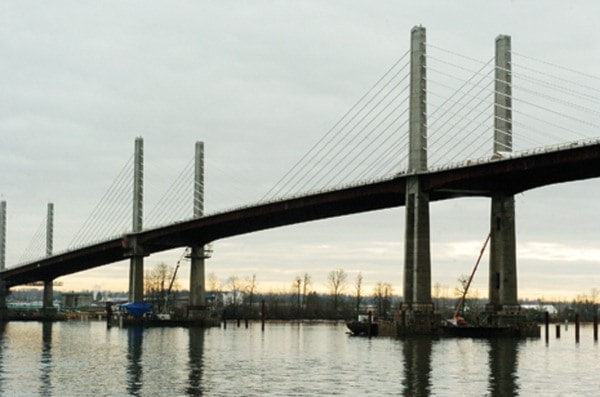TransLink will no longer meet with residents in Pitt Meadows and Maple Ridge to deal with noise and drainage issues associated with the Golden Ears Bridge.
A community action group, which has been meeting with the provincial transportation authority since September, convened for the last time on Thursday, much to the dismay of residents who feel many issues have yet to be addressed.
TransLink originally committed to meet with the residents for at least six months, or longer if needed.
“We feel manipulated,” said Mike Stark, the newly-appointed president of the South Pitt Meadows Residents Association.
In December, TransLink pitched nine options to dampen noise from the bridge, including increasing the height of a concrete wall, planting evergreen trees and installing signage telling drivers to reduce their speed.
Residents were asked to pick an option, or two, as moving ahead with all nine would cost more that a million dollars, exceeding the $500,000 budget that is available.
Instead of allowing residents to make a choice, TransLink instead picked one for them by deciding to proceed with either increasing the height of an existing sound barrier by 1.5 metres (five feet) or building a brand new one that is four metre in height (15 feet) to dampen the sound of traffic along Golden Ears Way and Airport Way.
“They’ve arbitrarily imposed this on us,” said Stark.
In addition to a sound barrier, TransLink will monitor expansion joints on the Golden Ears Bridge daily to ensure the cloth-like inserts meant to make the span quieter haven’t popped out.
TransLink has already spent $600,000 installing the “geotexile” sound-absorbing inserts.
While the expansion joints meet transportation ministry standards, the incessant croaks and thumps from vehicles driving over the gaps between them have been a nuisance for people in nearby neighbourhoods since the bridge between Maple Ridge, Pitt Meadows and Langley opened in June 2009.
Stark, however, believes TransLink had no choice but to increase the height of the sound barrier because it was not built high enough to block out the sound of large trucks.
“Where was that in the original design? Was that a huge oops? I think we caught them off guard,” he added. “I actually think they’ve shut this group down because there is more stuff coming up and they don’t want to deal with it.”
Residents have repeatedly requested documents from TransLink, which they have not yet received, including the sound measurements conducted before the bridge and its road network were built.
Many residents still want TransLink to install sinus-plates over the expansion joints – an expensive fix that TransLink is not open to.
Pitt Meadows Mayor Deb Walters believes TransLink’s solutions to reduce noise fall short.
“I must say, I am disappointed that a decision was made by TransLink and presented to the community without advising our council prior to their announcement to the community action group,” said Walters. “I am also disappointed that they have dissolved this group when it appeared that progress was being made by both sides.”
